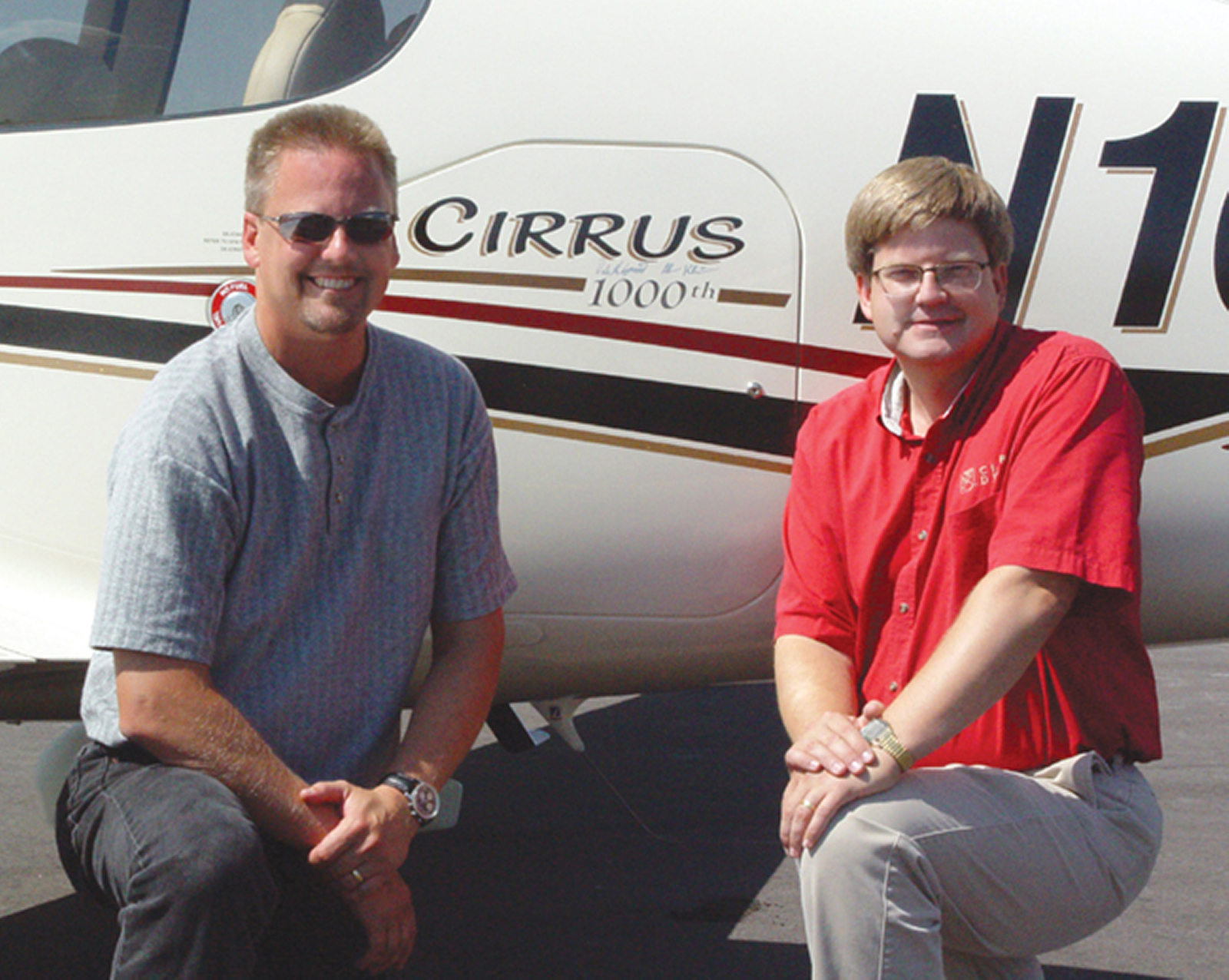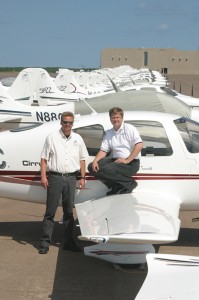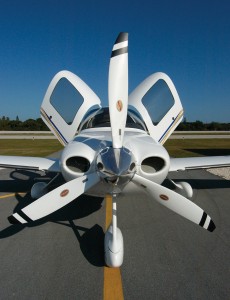By Karen Di Piazza
Alan and Dale Klapmeier, Cirrus Design Corporation cofounders and owners, began their Duluth, Minn.-based company in 1979, when they started to build their kit airplane in their parents’ barn. Today, the brothers, both active pilots, manufacture FAA-certified composite, single-piston engine, four-seat planes. The futuristic, sleek-looking planes have oversized, “swooped-up-angled,” two-door designs that have caught the eye of about 1,400 buyers thus far.
“After 25 years, we’re an overnight success,” laughed Alan Klapmeier, Cirrus CEO, president and director.
Last September, TIME Magazine said it was “blue skies for Cirrus,” and credited the Klapmeiers with “giving lift to the small-plane industry with an easy-to-fly design.” In April 2004, Forbes said Cirrus sells “meaning.”
“They ask pilots to participate in something greater than themselves–the aviation revolution,” the article said. “Fly a Cirrus and you’ll be part of history.”
The article credited Cirrus for not using “sex” to sell its aircraft. Alan Klapmeier laughed, saying some people would disagree. After one company ad proclaimed their product “Something else with curves that a man can trust,” several women pilots called in asking what that was supposed to mean.
“The words emphasized ‘something else,’ and it wasn’t supposed to be a negative,” he said. “One of the women on our staff came up with that ad.”
Cirrus Outsells Its Competition
Cirrus sold 105 airplanes in the first quarter of 2004, outselling their Wichita competitor, Cessna Aircraft Company, by 16 aircraft. They sold more four-seat aircraft than any manufacturer in the world.
This is a remarkable accomplishment when you consider that Cirrus only began producing its aircraft in 1999; they’re the fastest growing general aviation manufacturer in the world. In 2001, Cirrus had captured just 11 percent of the market for single-engine piston planes; to date, they’ve captured almost one-third.
“We’re obviously pleased with the results, and proud of the fact that we’ve been able to increase our sales,” said Alan Klapmeier. “It’s good for us and it’s good for the industry.”
However, he said everyone missed the “real” story: Cirrus is trying to figure out how they can change the industry, and how they can change people’s perspectives on owning airplanes.
“That’s more of the goal than passing Cessna on a production number or achieving a quarterly record,” he said. “It may be the results, but it’s not our goal. The comparison made between Cirrus and Cessna is apples and oranges anyway; we sell factory direct, and they sell through dealers. There’s always going to be some variation in terms of how the numbers are counted. We plan to continue increasing our sales; we’re producing two aircraft a day. Our main limitation is how many we can build at any one time.”
Cessna, now in its 77th year of business, stopped producing single-engine piston planes in 1986, after product liability issues caused the whole industry to spiral down. However, the single-engine piston market was renewed in 1994, when Congress passed the General Aviation Revitalization Act. GARA, which established an 18-year “Statute of Repose,” immediately resulted in Cessna producing piston aircraft in 1996.
When looking at the playing field, and realizing Cessna only had a three-year jump on Cirrus’ single-engine aircraft, after GARA, it’s not that inconceivable that Cessna would have competition in this market today.
In a recent conversation, Cessna CEO and President Jack Pelton said that Cirrus is real competition. (Read July’s issue for the full, exclusive story).
“There’s no doubt about it, they are real competitors, but we’re not going to let them take control,” said Pelton.
Alan Klapmeier said he hasn’t met Pelton, but he’d like to.
“I’d like to be able to sit down with him and listen to what his vision is about the industry,” he said.
He said he envisions Cirrus manufacturing a personal jet.
“We’ve believed for a long time that the market will grow and that there will be products available to people as personal jets,” he said. “But we believe ‘personal’ jets will be very much differentiated, as opposed to small ‘business’ jets. That’s down the road, but we do look forward to getting into that market.”
Cirrus’ lowest priced plane is the SRV-G2, which is VFR only, base priced at $189,900, loaded at $265,825. The SR20-G2 is IFR certified, based at $236,700, loaded at $314,065. The newest is their IFR certified SR22-G2, based at $328,700 and loaded at $436,650. All of their planes come standard with a glass cockpit and the Cirrus Airframe Parachute System. For an additional level of security, the SR22 has an optional ice protection system. The SR20 has a Continental-10-360-ES, 200 hp; the SR22-G2 has a Continental-10-550-N, 310 hp.
Crash Reports
Although Cirrus’ sales are skyrocketing, the Klapmeiers have had to deal with articles about crashes, which leave out necessary details. For instance, in February 2003, the Associated Press wrote, “a rash of deadly crashes threatens Cirrus Design.”
The article accused Cirrus of potentially becoming the maker of the “next doctor killer,” a nickname that had been associated with the Beech Bonanza’s V-tail plane, another high-performance single-engine that was involved in a series of fatal accidents in the late seventies and early eighties.
“The company promotes its planes as dramatically safer and easier to fly than the classic tried-and-true design of Cessna, Piper, Mooney and Beechcraft–but fatal Cirrus accidents have occurred at nearly three times the national rate and there’s no obvious pattern to the accidents,” the article said.
The article said that in three and a half years, 11 people had died in seven crashes, and that in six other nonfatal Cirrus crashes, injuries ranged from scratches to paraplegia.
At the time of these accidents and nonfatal accidents, which occurred in 2001 and 2002, Cirrus’ Flightmax Entegra PFD glass cockpit hadn’t been introduced yet; it became available in February 2003. Additionally, the National Transportation Safety Board’s preliminary report indicated that only one pilot held more than a private certificate.
Dale Klapmeier, Cirrus’ executive vice president, said to date there’ve been eight fatal accidents, and 17 people have died. The most recent occurred April 19, 2004, when a SR20 exploded on the ground, near Greenwood County Airport in South Carolina, and killed the pilot and its three passengers.
Although the Klapmeiers can’t comment about that incident, since it is under investigation by the NTSB, and by their own internal safety counsel, Dale Klapmeier did say that 10 of the people who have died lost their lives because of pilots’ poor decision making–VFR rated pilots flying into IFR and instrument meteorological conditions.
“VFR flying into IMC is a major problem for our industry,” he said. “Most aircraft that fly are IFR rated aircraft. The fact that we offer a VFR-only aircraft is an attempt to offer a product to a very specific audience.”
The VFR aircraft became available in July 2003.
“What our aircraft offer is an easier aircraft to fly with better avionics, and better information to the pilots; this will not replace good judgment,” he said. “Ten people have lost their lives to this specific lack of judgment.”
He said people have criticized Cirrus because their aircraft is easier to fly in IMC conditions.
“We’ve been accused that it’s led people to make ‘more risky decisions’ than other aircraft, which is not true,” he said. “As a designer and manufacturer, we give the pilot better information, better safety devices, a better flying aircraft and we train extensively.”
They train extensively in areas of aircraft handing and performance, and they discuss judgment issues. Bill King, vice president of business administration, who oversees daily operations and handles all insurance issues at Cirrus, says their aircraft have proven to be safer–regardless of what the media has reported.
“Early in our delivery history, our new design concept did create a situation where some underwriters raised concern about the aircraft; some of them elected to take a wait-and-see approach,” King said.
He said they had five initial accidents where pilots were involved in controlled flight into terrain (CFIT), which caused some underwriters to question the safety record of the aircraft.
“Since then, the SR series has proven itself as very safe,” he explained. “Our SR22 has established itself in the market as one of the safest GA aircraft in the fleet. Safety data now shows the SR22 has a safety record inclusive of fatal accidents per aircraft delivered, about a third that of the Cessna 182.”
He said Phoenix Insurance, who initially was unwilling to underwrite Cirrus’ line of products, does now.
“Neither the Federal Aviation Administration, nor the NTSB, has ever issued a probable-cause ruling calling into question any product, design or defect of any kind, as a result of their findings from any accident or incident,” he said. “If the accident statistics were truly problematic, underwriters wouldn’t underwrite; new underwriters wouldn’t agree to underwrite. We agree with insurance underwriters that specific skills be demonstrated, and that proficiency programs be required in order for customers to receive favorable rates for their plane.”
King said they want insurance companies not only to recognize their training, but also to require customers to complete the currency courses and specific additional training initiated by Cirrus.
“We believe it’s key to our customers continuing to fly their aircraft in the safest manner,” he said. “We believe our safety record now effectively demonstrates this.”
GA TAA Industry Safety Study
In 2002, Paul Fiduccia, who is president of the Small Aircraft Manufacturers Association, which represents 35 GA manufacturers, led the GA TAA Industry Safety Study, in a joint effort with the FAA. The study took one year; after August 2003, it became part of the FAA’s training syllabus.
“The focus on the study was on technically advanced aircraft, which is aircraft that has at least an IFR-certified GPS with a moving map and auto-pilot together,” said Fiduccia. “The purpose wasn’t to focus as much on Cirrus, but we did, because we knew then how the aircraft were equipped at the time of the fatal and nonfatal accidents.”
He said just looking at NTSB reports, they don’t specify if they were TAA, but they knew Cirrus was the first large fleet that had TAA. They examined Cirrus’ records and established what options the customer added as well, so they used Cirrus as their model for the industry.
“We wanted to find out what the GA industry should expect from the accidents; we looked at them to find out if they were TAA related,” he said. “None of them were. What were we going to do when Cessna and Piper started doing this? We knew everyone else in the industry would follow Cirrus’ lead.”
One of the findings from the study showed that the safety problems were typical of pilot errors–poor judgment about their skills and capabilities.
“Half of Cirrus’ accidents were VFR pilots in bad weather–classic GA accidents that had nothing to do with avionics or anything else,” he said. “They were pilots that weren’t rated or qualified to fly in bad weather, but in fact, they flew in bad weather. They got off course, and either ran into a mountain, ran into the rising terrain, or lost control.
“The study’s recommendation was that aircraft should have a terrain-warning-system or weather-data link,” he said. “Cirrus is making all this available to pilots as purchase options.”
On another occasion, an IFR-rated pilot took his first IFR flight at night, and the weather was bad.
“Instead of waiting until daylight, he proceeded because he was pressured to go; his girlfriend’s parents were picking them up,” he said. “Other accidents involved more than IMC; some were in icy conditions–a whiteout.”
He said when the Piper Malibu, Beechcraft Bonanza and Cessna Cardinal aircraft first came out, they were considered advanced and there were more accidents in them.
“Pretty much anything that’s new or different, there tends to be accidents in them,” he says. “The cause of that is training; the training system hasn’t figured out yet, ‘These are different.'”
Another recommendation of the study was to offer advanced training for today’s pilot flying TAA. He said, in that regard, Cirrus provides excellent training and that their study concluded that Cirrus’ TAA had nothing to do with causing the accidents.
He said that 20 percent of GA accidents are due to mechanical mishaps; 80 percent are pilot error. Numerous accidents were attributed to “get-home-itis,” a term Fiduccia said sounds more like a “disease,” and instead should be called, “if you have a schedule.”
“If you don’t have a schedule to meet–that you don’t have to keep–you don’t need an IFR certificate,” he said. “Some pilots who purchased a Cirrus are retired people. They’re going out golfing somewhere. It doesn’t matter if they get there on a Monday or Wednesday; if they run into bad weather, they can spend the night somewhere.”
But some pilots, he said, fool themselves into believing they can maneuver in unexpected weather conditions.
“Sometimes a VFR pilot thinks, ‘There’s just a little cloud; I think I can fly through the other side it,’ but that’s how accidents happen,” he said. “They can’t see, they lose control and run into something. I think Cirrus was very smart in coming out with the first VFR-only plane. This will force the pilot to make a choice, and the price is much less to purchase a VFR plane. I guess you could ask, if you’re not IFR rated, and you don’t plan on becoming IFR rated, what in the hell are you doing buying an IFR plane, except to test fate?”
Regarding Cirrus’ recent accident on April 19, which wasn’t part of the study, Fiduccia said weather wasn’t a factor.
“I’m reading the NTSB preliminary report; the final one could take up to six months, but according to a pilot-witness statement, it appears that the pilot was showing off or something,” he said. “The plane almost collided with trees as it veered straight up in the air at the end of the runway.”
However, he said, sometimes the problem was the fact that most new airplanes are owned by FBOs, clubs, shared-ownership and fractional operators, which aren’t going to buy a VFR only plane. They wouldn’t be able to use them for flight instruction, or lease them out, etc. Financially, it wouldn’t make sense.
Fiduccia, who’s been flying for 40 years, has commercial, multiengine, land and sea ratings, and said he’s the perfect example of someone who has a shared-ownership arrangement on his Mooney; his wife, also a pilot, shares ownership on a Beech Sport.
“It’s just too expensive to own one alone; in our case, we need IFR aircraft for business,” he said.
He said another recommendation from the study was that GA aircraft should have a primary flight display, and Cirrus immediately complied.
“Their competitors immediately followed,” he said.
However, Dale Klapmeier believes all of their pilot customers should get an IFR license, because those pilots have gone through more training and can better handle adverse weather situations that may arise. He compares that with our nation’s highways.
“Why do people still lose control of their cars?” he said. “When it snows, the accident rate on the highways goes up; don’t people know it’s slippery on the roads when it’s snowing? You don’t need an IFR rating to fly our airplane, but you need an IFR rating to fly in IMC.”
He added that approximately 15 people would say that because of their TAA aircraft, they’re alive.
“And that’s not including a chute pull,” he said.
BRS/CAPS
Alan Klapmeier said some people have accused Cirrus of being a “dangerous” company.
“Some people in our industry believe fewer people should fly, therefore, we’re ‘dangerous’ because we’re encouraging people to fly that shouldn’t!” he said. “We believe more people should, can and will fly, but doing it more safely is the key. Some people in my industry believe the industry isn’t any larger because people can’t handle it. They believe the industry should stay small, so those naïve, incapable and dangerous people don’t try to learn how to fly, because based on their assumptions, they can’t handle it.”
He said people in his industry believe CAPS is an excuse, and that less-trained, less-qualified pilots will fly their aircraft thinking, “If it doesn’t work out, I’ll just pull the chute.”
“That’s absurd,” he said.
CAPS, manufactured by BRS, Inc., a 24-year-old $6.5 million Minnesota-based company, has designed, sold and delivered 18,000 parachute systems for use with various military and civilian unmanned aircraft.
Alan Klapmeier explained that in an emergency, as a last resort in saving your life, or that of passengers, you can activate the parachute and your plane will float to the ground–as opposed to crashing onto the ground without one.
When Cirrus certified its SR20 in 1998, it became the only GA manufacturer in the world to offer a rocket-deployed airframe parachute as a standard feature.
In 2002, for the first time in history, a certified aircraft, a Cirrus aircraft, landed via parachute, and the pilot walked away injured.
Alan Klapmeier said there have been three separate incidents to date involving parachute deployments and landings. Because of CAPS, six people are alive.
Ironically, the second and third CAPS deployments, April 8 and 10, were 36 hours apart. One was in Colona, British Columbia, and the other in Fort Lauderdale, Fla.
Cirrus aircraft has a 3G-roll-cage, which supports its cabin and occupants; each seat has a four-point safety harness.
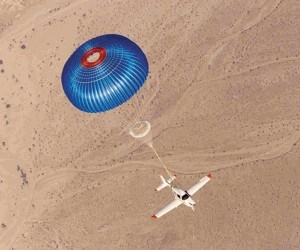
The Cirrus CAPS/BRS deployment has saved six lives to date. The parachute lowers the pilot and passengers to the ground safely.
Another CAPS survivor, said it was a “nonevent” when his plane landed, and described its descent as reasonably flat into the trees, with most of the damage to the plane occurring because of tree contact, not ground contact. The pilot said he “didn’t feel” the ground contact.
Cirrus’ all-composite main landing gear can absorb up to 40 Gs, which has proven to be an extremely resilient design that helps absorb impact during a CAPS landing. Cirrus’ CEAT proprietary design, which is integrated into each aircraft seat, absorbs energy equivalent to 26 times the force of gravity vertically.
In any of these events, if the plane’s doors wouldn’t have opened, the pilots or passengers would’ve been able to escape through the oversized windows, using an egress hammer located in the center console with which Cirrus equips all aircraft.
Cirrus’ courage to buck the status quo, similar to the pioneers that invented seatbelts and airbags, has proven to save lives. The Klapmeiers don’t understand why their competitors aren’t using parachutes or why they’re still met with skepticism from industry insiders, who still believe that airplanes don’t need parachutes.
Alan Klapmeier said he finds it appalling that some industry insiders have insinuated that pilots “get what they deserve.” Further, he said that some industry people have accused his company of being “hucksters and profiteers” because of CAPS. However, Cirrus spent over $10 million on developing CAPS.
“That really irritates me,” he said. “I’m a survivor myself of a midair collision that claimed the life of another pilot in another plane; I made a promise that when we manufactured aircraft, we’d have a parachute recovery system; people don’t have to die.”
He said the midair collision happened when he was working on his instrument rating while flying his father’s Cessna 182 RG, and if that plane would’ve had a parachute, he would’ve used it.
“I’ve had three occasions in my life where if I would’ve had a parachute on the aircraft, I would’ve used it,” he said. “They could’ve ended up being fatal.”
He said those experiences, the ones he’s read about, and the fact he’s lost test pilots at Cirrus made him even more determined to make sure CAPS got off the ground.
Piper, Cessna, Beech and Mooney lost test pilots during the development and testing of their aircraft; Cirrus has lost two test pilots. Scott Anderson, who was an F-16 pilot with the Minnesota Air National Guard, was the second test pilot that was killed; CAPS wasn’t available yet in the SR20 he was flight testing. Former NASA Space Shuttle Commander Bob Overmyer, who was killed while flying the kit VK-30, was wearing a chute, but he didn’t deploy it; CAPS didn’t exist then.
The Heart Of A Pilot
Alan Klapmeier said flying is an act of conquest. Pilots should be secure in their mastery of the machine and relaxed among controls that are an extension of their senses.
“We give ourselves up to the exhilaration of slicing through altitudes,” he said. “We understand this experience; it informs every design decision we make. We design with the mind of engineers, but the heart of a pilot. Have you driven a BMW? People talk about the BMW as being the ultimate driving machine; it’s very responsive and intuitive. Our aircraft is the BMW of the sky.
“Our aircraft has different stall characteristics that make it less likely for you to have a departure from control at a stall; it gives you aileron control in a stall. We design products that are more intuitive; to do what you expect it to do, opposed to what you’re taught to have it do.”
Their aircraft have “air superiority” because of composite construction and technological advancements.
“Composites aren’t new; they’ve been used in the boat and automotive industry for years,” he explained. “They’ve been used in aircraft design for over 50 years. Composites play key roles at Airbus, Boeing and in the U.S. Air Force stealth program. Our unique wing design features, tested and proven by NASA, provide an improved resistance to spin entry during an inadvertent stall.”
The Klapmeiers believe in giving “power to the pilot”–engine power. Teledyne Continental six fuel-injected cylinders and balanced exhaust system makes for a smooth, low-vibration, but fast ride. When it came to designing the aircraft’s 49-inch wide interior, they modeled it after the car industry.
“The instrument panel was moved forward, generating more roominess,” said Alan Klapmeier. “We designed it asymmetrical and oriented it left, giving the pilot the best seat in the house. The stick is on the left as well to prevent injuries.”
To prevent pilot fatigue, the seats, which are ergonomically designed, conform to the shape of your body. The interior has environmental controls, personal entertainment hook-ups and low-stress lighting.
Cirrus’ Avidyne 10.4-inch Primary Flight Display won the editor’s choice award in Flying Magazine in January. The glass cockpit includes a 10.4-inch multi-function display and two additional five-inch screen GPS receivers. The Cirrus glass cockpit was the first personal GA plane to have the autopilot integrated with the PFD; it provides altitude pre-select, altitude hold and vertical speed select. The MFD has a myriad of functions, ranging from flight planning, en route, waypoint and destination information, weather, traffic and terrain data. It also monitors the engine.
The Cirrus SR22 was chosen “Best of the Best 2003” in its class by Robb Report Magazine. During that same year, the SR20 and SR22 won their respective categories, with the SR22 winning overall in Plane and Pilot Magazine’s “Reader’s Choice Awards.”
Cirrus produces two aircraft a day in their Duluth, 111,000-square-foot manufacturing plant, which is adjacent to its 30,000-square-foot research and development facility.
Philosophy On Life And Business
Alan Klapmeier said he agrees with sociologists that claim we’re approaching a “great awakening.” If it weren’t so, he noted, 15 million copies of the book, “The Purpose-Driven Life,” wouldn’t have been sold.
“I believe our country has a business ‘culture’ problem,” he explained. “I think we have a lot of issues in the country about people who think business is next quarter’s profits, as opposed to asking what the vision, direction and action in their company, their industry, what the whole thing should be. We really do get that screwed up.
“I absolutely agree that we’re on the edge of a ‘great awakening,’ and I believe that businesses need to pay attention to this trend, if they want to be successful.”
He said he understands why the 77 million baby boomers, who are the median age of 50, are questioning their earthly existence; they’re looking for more than hype in their lives, which is reflected in the products they buy today.
“They’re looking for purpose and honesty in their lives,” he said. “People are willing to do something different, to find out what that is.”
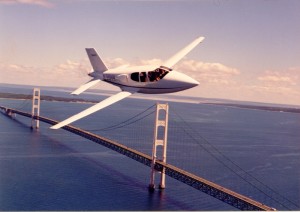
Cirrus cofounders and owners Alan and Dale Klapmeier built this kit plane, the VK-30, in their parent’s barn. The plane launched the company into success.
He said that in terms of their outlooks, how they differ, he’s more of a dreamer.
“Dale is more practical,” he said. “He figures out how to make it work.”
He says, in fact, his brother is “unbelievably practical.”
“It drives the engineers crazy,” he said. “The engineers work on something for weeks, and Dale walks in and says, ‘Okay, but what about this?'”
Alan Klapmeier adds that their business philosophy is relationship driven–clientele and employees.
“We know the name of every person who has purchased our aircraft; we get to know them and their family members,” he says. “I’ve taken calls at home.”
In fact, people have often told him he’s not the typical CEO.
“If that means not being a shuffling-papers, tie-wearing, hayseed kind of guy, I guess that’s true,” he laughed. “I’ve had people say they were surprised to learn that I don’t own a pair of bib-overalls; it is Minnesota, and that’s the mentality some people have.”
He said he’s often mistaken for a Cirrus demo pilot.
“I guess people aren’t used to seeing a CEO sitting on the wing of a plane, dressed casually, wearing a short-sleeved shirt, or laughing and chatting it up with people,” he said. “It surprises them to find out the CEO just gave them a detailed tour of the plane, but I love doing that.”
Dale Klapmeier, who spends much of his time overseeing the nuts and bolts of the business, says he’s no tie-wearing executive either, and when weather permits, he rides his black Harley-Davidson motorcycle to work.
From Cirrus clouds–To Making It
The Klapmeiers have had a passion for aviation since childhood. Both brothers were in the Civil Air Patrol cadet program in high school. Their first plane they bought together was a wrecked 7-GC 1960 from the Champion Corp., which they rebuilt. Their father had a 1960 Cessna 182; later, he bought a 1981 C-Skylane 182 RG.
In 1979, Dale Klapmeier graduated from the University of Wisconsin-Stevens Point with a degree in business administration. Alan Klapmeier had graduated from Ripon College with degrees in physics and economics two years prior.
Soon after, the Klapmeiers were driving down the road making plans for their business, when they looked up and saw Cirrus clouds, and knew they had found a name for their company. They thought their parents, also entrepreneurs, were likely to help them.
“They had started nursing homes in Illinois and owned several of them by the time we talked to them about our company; we knew they’d understand,” said Alan Klapmeier. “We also had an uncle that owned a boat manufacturing company, so no one in our family viewed the idea of starting an aviation company as impossible.”
They were off to a good start, and their parents let them move into the family vacation farmhouse in southern Wisconsin, which is where they would build their first kit airplane.
“We didn’t have to pay rent, and the barn became our factory,” laughed Alan Klapmeier. “Those were lean times; we ate a lot of macaroni and cheese, frozen pizza, and Dakota Hearth bread–frozen, uncooked dough.”
In 1984, after years of struggling, they officially incorporated as Cirrus Design in Baraboo, Wis., and began production on their custom VK-30, a kit, four-place composite pusher with conventional wings and tail. It’s the only kit aircraft that Aviation Week and Space Technology magazine has featured on its cover.
The memory of first raising money is painful, the brothers said. Alan Klapmeier recalled a phone conversation with an investment manager, which was an exhausting effort.
“I gave him the history, our process, what stage we were at, all the demographics and logic on the market,” he said. “We hadn’t delivered any aircraft, but we had a lot of orders. After all that, he said, ‘But how do know you haven’t sold the very last airplane that can be sold?’ Out of frustration, I said, ‘How do you know that McDonald’s hasn’t sold their last hamburger?”
They never gave up trying to raise money. In 2001, Crescent Capital, a private firm, invested $100 million into their company.
“We’ve worked very hard; no regrets,” said Alan Klapmeier. “We love what we do.”
For more information, visit www.cirrusdesign.com.











